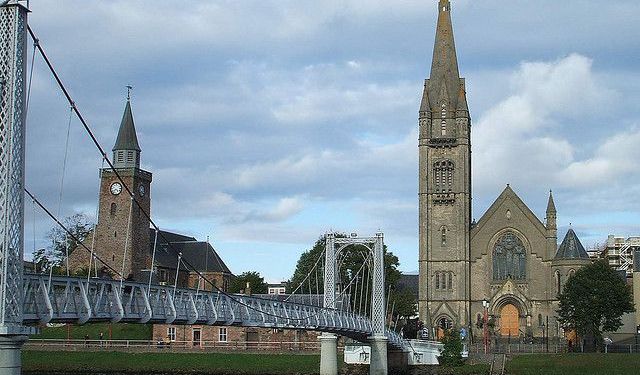
Fort George, Inverness (must see)
Fort George (Gaelic: Dùn Deòrsa or An Gearastan, the latter meaning literally "the garrison"), is a large 18th-century fortress near Ardersier, to the north-east of Inverness in the Highland council area of Scotland. It was built to control the Scottish Highlands in the aftermath of the Jacobite rising of 1745, replacing a Fort George in Inverness constructed after the 1715 Jacobite rising to control the area. The current fortress has never been attacked and has remained in continuous use as a garrison.
The fortification is based on a star design; it remains virtually unaltered and nowadays is open to visitors with exhibits and facsimiles showing the fort's use at different periods, while still serving as an army barracks.
The barracks are still in use as a military establishment, but much of the site is open to the public (entrance charge). Historic Environment Scotland use part of one of the barracks to display reconstructions of life in the early days of the fort, and the Grand Magazine displays the Seafield Collection of Arms as well as forming a stage for actors recreating the lives and stories of soldiers in the 18th century. The site received 76,169 visitors during 2019.
The fortification is based on a star design; it remains virtually unaltered and nowadays is open to visitors with exhibits and facsimiles showing the fort's use at different periods, while still serving as an army barracks.
The barracks are still in use as a military establishment, but much of the site is open to the public (entrance charge). Historic Environment Scotland use part of one of the barracks to display reconstructions of life in the early days of the fort, and the Grand Magazine displays the Seafield Collection of Arms as well as forming a stage for actors recreating the lives and stories of soldiers in the 18th century. The site received 76,169 visitors during 2019.
Sight description based on Wikipedia.
Want to visit this sight? Check out these Self-Guided Walking Tours in Inverness. Alternatively, you can download the mobile app "GPSmyCity: Walks in 1K+ Cities" from Apple App Store or Google Play Store. The app turns your mobile device to a personal tour guide and it works offline, so no data plan is needed when traveling abroad.
Fort George on Map
Sight Name: Fort George
Sight Location: Inverness, Scotland (See walking tours in Inverness)
Sight Type: Attraction/Landmark
Sight Location: Inverness, Scotland (See walking tours in Inverness)
Sight Type: Attraction/Landmark
Walking Tours in Inverness, Scotland
Create Your Own Walk in Inverness
Creating your own self-guided walk in Inverness is easy and fun. Choose the city attractions that you want to see and a walk route map will be created just for you. You can even set your hotel as the start point of the walk.
Inverness Historical Buildings Walking Tour
Inverness, a city established in the 12th century, boasts an array of historical architecture reflecting its rich and often tumultuous past. Many of its centuries-old buildings are situated along the banks of the River Ness and blend effortlessly with the surrounding landscape.
Undoubtedly, prime among these is the Inverness Castle, perched majestically atop a hill overlooking the city.... view more
Tour Duration: 2 Hour(s)
Travel Distance: 2.0 Km or 1.2 Miles
Undoubtedly, prime among these is the Inverness Castle, perched majestically atop a hill overlooking the city.... view more
Tour Duration: 2 Hour(s)
Travel Distance: 2.0 Km or 1.2 Miles
Inverness Introduction Walking Tour
Often regarded as the Capital of the Scottish Highlands, Inverness is steeped in history and legend. The name "Inverness" derives from the Scottish Gaelic "Inbhir Nis," which means "mouth of the River Ness," a fitting moniker for a city that thrives along the banks of this scenic waterway.
The Inverness area has been inhabited since 6500 BC, once being a... view more
Tour Duration: 2 Hour(s)
Travel Distance: 2.3 Km or 1.4 Miles
The Inverness area has been inhabited since 6500 BC, once being a... view more
Tour Duration: 2 Hour(s)
Travel Distance: 2.3 Km or 1.4 Miles


